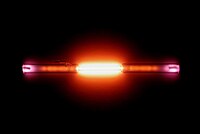
Photo from wikipedia
Abstract The samples with the CaFe2O4-type crystal structure were obtained by the solid-state reaction method at 1000 °C in the air and the helium atmosphere for the first time. We investigated… Click to show full abstract
Abstract The samples with the CaFe2O4-type crystal structure were obtained by the solid-state reaction method at 1000 °C in the air and the helium atmosphere for the first time. We investigated the modification of the structural and electronic properties of the obtained samples. Mossbauer, XAFS-, XPS-spectroscopies, and dc-, ac-conductivity measurements were carried out. Mossbauer and XAFS-spectroscopies showed that the local environment of Fe and Ca cations does not change in the case of the inert atmosphere synthesis. Nevertheless, a sharp six-order increase in the electrical resistance observed at room temperature for the sample obtained in the in the helium atmosphere. Moreover, calculated from dc-conductivity data activation energy rises from 0.327 for the air-synthesized sample to 0.585 eV for helium-obtained one. This behavior indicates significant modification of in-band-gap energy structure, which correlated with thermally activated charge carriers. Our ac-conductivity measurements in the frequency range of 1 kHz–2 MHz for the CaFe2O4 obtained in the air showed the presence of defect levels in the energy band structure. Oxygen pressure reduction during the synthesis results in levels vanishing. Therefore, we suppose the key role of oxygen atoms in the transport properties of the material, which is indirectly confirmed by XPS data. In prospect, CaFe2O4 can be used in promising gas analyzers.
Journal Title: Journal of Alloys and Compounds
Year Published: 2020
Link to full text (if available)
Share on Social Media: Sign Up to like & get
recommendations!